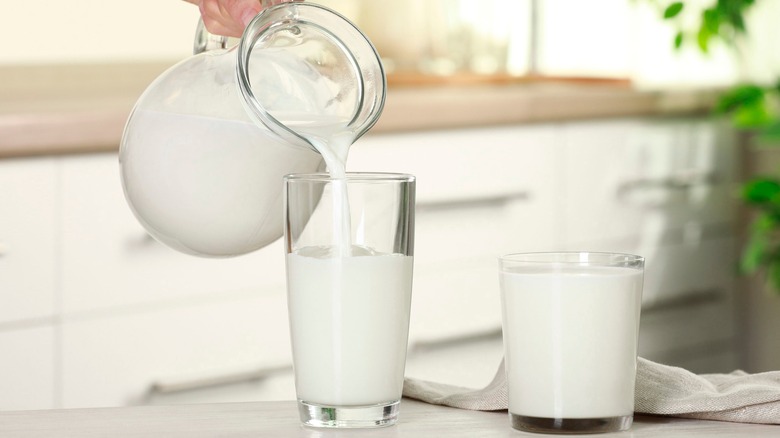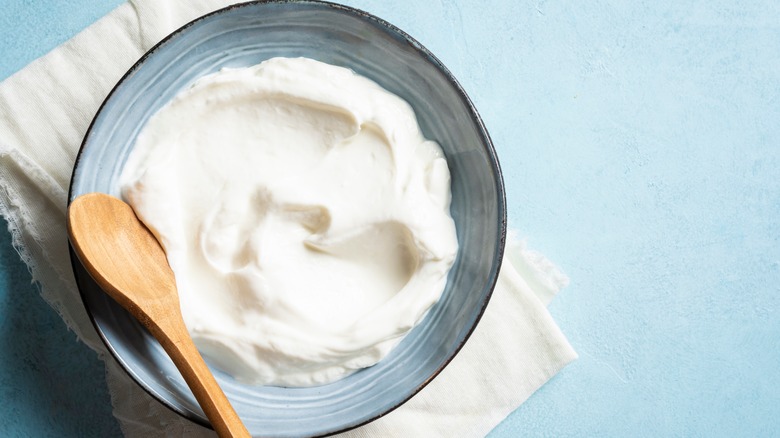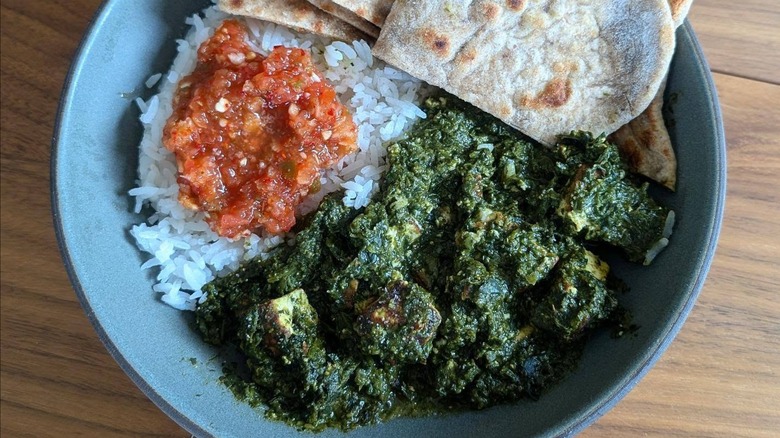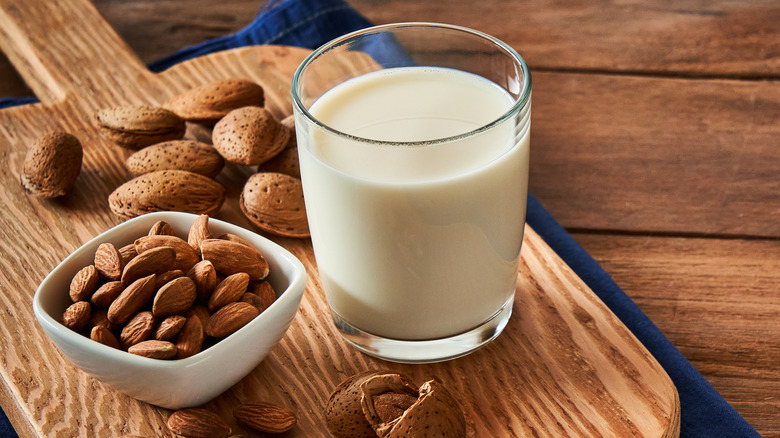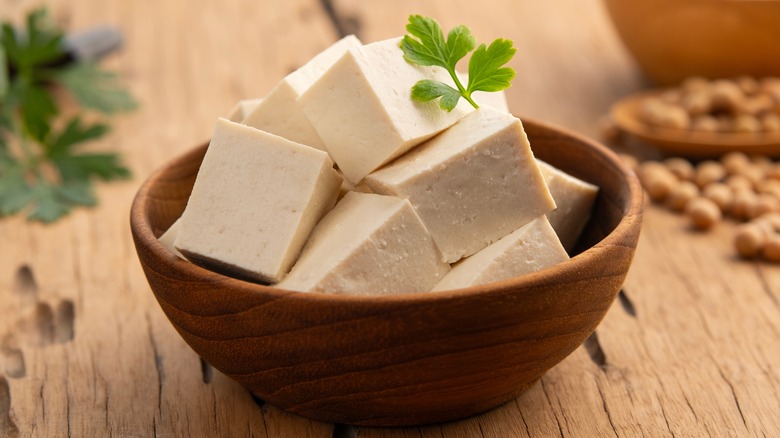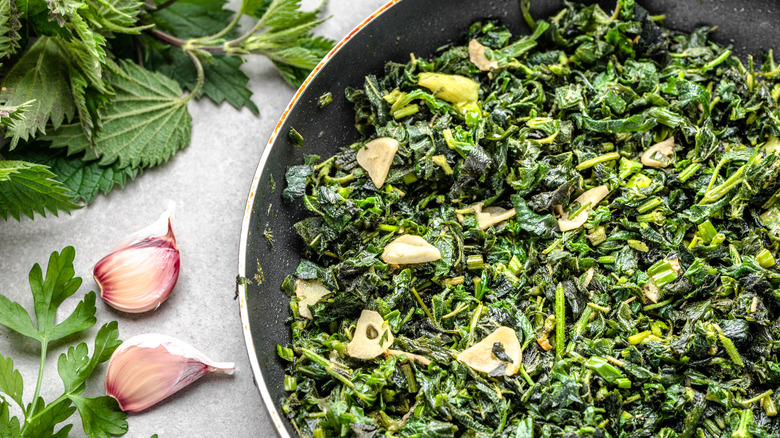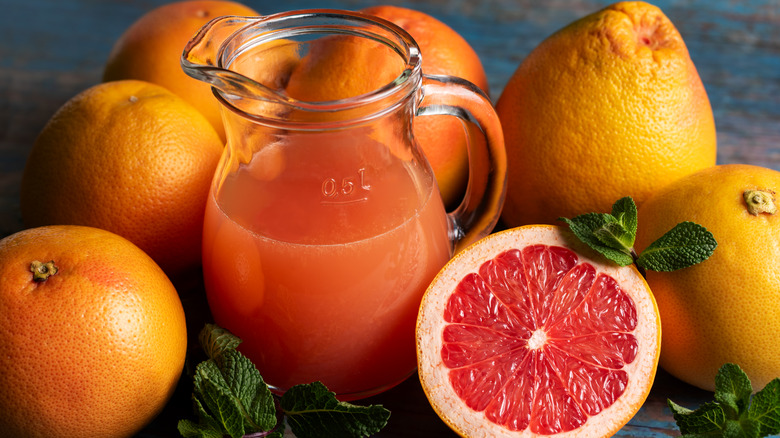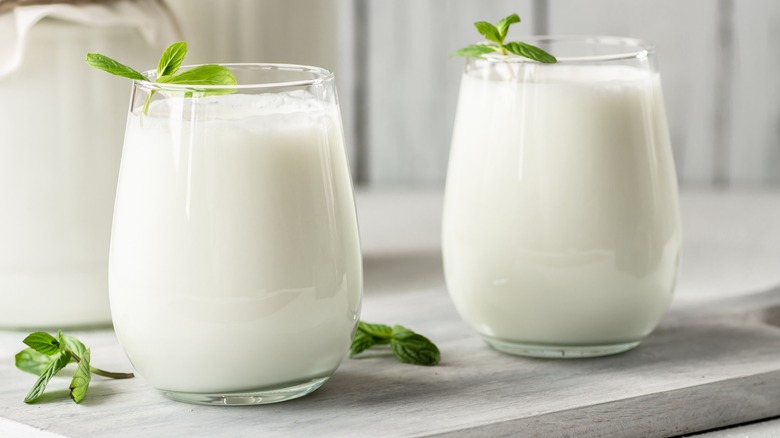9 Foods With More Calcium Than A Glass Of Milk
The foods that you eat have a big impact on your body. Beyond satiating hunger, foods can be naturally rich in nutrients or fortified to provide what your body needs to function properly and fight off disease. According to the Dietary Guidelines for Americans, calcium is one nutrient that the average American doesn't get enough of, which can lead to health concerns. Drinking a glass of milk can boost your intake, as milk is a good source of calcium. It's generally recommended that a balanced diet include only low-fat and fat-free milk. With that in mind, 1 cup of low-fat (1%) milk has about 306 milligrams of calcium. The amounts in fat-free (skim) milk and low-fat buttermilk are similar, at 298 milligrams and 284 milligrams, respectively.
The Mayo Clinic recommends that adults aged 19 to 50 should consume 1,000 milligrams of calcium per day. This means that most people would need to drink more than 3 cups of low-fat milk every day to achieve that objective. The problem is that some people find the plain flavor of milk boring no matter how high the product ranks in Daily Meal's ranking of milk brands, while others are allergic to dairy proteins. Fortunately, several dairy and nondairy foods contain more calcium than 1 cup of 1% milk to help you reach the daily recommended goal.
Plain yogurt
Yogurt is made by thickening milk, either with the addition of milk powder or gelatin or through evaporation. After pasteurization, good bacteria are added, and the milk is allowed to ferment, creating its signature tangy flavor and creamy consistency. These processes essentially concentrate the milk, so it's no surprise that yogurt is a calcium-rich food. In fact, an 8-ounce portion of low-fat plain yogurt has a whopping 448 milligrams of the micronutrient, while nonfat has even more at 488 milligrams. Keep in mind, though, that the same calcium content doesn't apply to Greek yogurt. An 8-ounce portion of low-fat Greek yogurt only has 261 milligrams, while the nonfat variety has 250 milligrams.
If you don't like the sour taste, there are many ways to level up plain yogurt. For instance, add fresh fruit, honey, and vanilla or other extracts for a flavorful breakfast or sweet treat, or add pesto to it to make a dip for fresh or roasted veggies.
Cooked lamb's quarters
Also referred to as wild spinach, goosefoot, or pigsweed, lamb's quarters is one of several plant species in the genus Chenopodium. This weed grows wild on every continent except Antarctica in disturbed soils rich in nitrogen, and it's a favorite among foragers for having a milder flavor profile than spinach that doesn't get bitter over time. Best of all, it's rich in calcium even after being cooked, with 464 milligrams per cup. By comparison, the same amount of cooked spinach only contains 245 milligrams.
Like spinach, you can eat lamb's quarters raw; include whole clusters of it in your salad to add texture to the bowl. But James Beard award-winning chef Alan Bergo says on Forager | Chef that you can cook them, too. Rather than boiling them, he recommends simply wilting them in a little liquid or oil. You don't have to waste time separating the leaves from the rest of the plant. Just chop the leaves and stems of the weed all together or cook the whole clusters like you would other small vegetables.
Fortified almond milk
Made from water and ground almonds (and sometimes flavorings and sweeteners), almond milk has become a popular alternative to cow's milk. Almond milk is a suitable milk replacement for those who are lactose intolerant, allergic to dairy, or vegan, and many prefer it to other lactose-free milk substitutes. Some products are fortified with extra vitamins during the production process. As a result, just 1 cup of almond milk can have up to 442 milligrams of calcium.
Numerous brands of almond milk are often available at stores worldwide, so you might be wondering which one is the best. When Daily Meal ranked 12 almond milk brands, Three Trees took the top spot, but it's unfortified and therefore, doesn't provide much calcium. Silk Original, on the other hand, was in the middle of the bunch in our ranking but offers 450 milligrams of calcium per cup. In light of these findings, it's important to check the nutrition label before you choose an almond milk brand if you're looking for the extra nutrients.
Raw tofu with calcium sulfate
When it comes to calcium, unsweetened soy milk already has a similar amount as low-fat milk — at 301 milligrams. Since tofu is made by condensing soy milk into blocks, it only makes sense that it would have even more of this nutrient. Tofu made with calcium sulfate (which is commonly added as a coagulant) has 434 milligrams per half cup.
The thought of eating tofu might be off-putting for some people, but that's usually because they haven't actually tried it or prepared it properly. There are different types of tofu you can sample to see which texture you like best — from silken and soft to medium-firm and extra-firm — and it's also important to use the correct type in certain dishes. Daily Meal can get you started with some tasty tofu recipes — such as cranberry tofu salad for sandwiches, which doesn't even require cooking the tofu. You can even put tofu in breakfast dishes and dinner entrees (try vegan enchilada casserole with chorizo tofu crumbles) as well as desserts (this dark chocolate tofu cheesecake with peanut butter pretzel crust sounds delicious).
Cooked nettles
Officially called stinging nettles (Urtica dioica), this perennial herb is another edible weed. It has been used to make dyes and cordage (the ropes on a ship) for thousands of years, and some cultures grew to revere it for its medicinal and nutritional properties. They were correct — just 1 cup of cooked nettles contains 428 milligrams of calcium.
However, it's important to note that you can't eat nettles raw like you would lamb's quarters and many other leafy greens. That's because, as the name suggests, touching the plant is known to cause a tingling, burning sensation that's like being stung by an insect, such as an ant or a bee. Some people even develop welts after contact. So, it's important to wear gloves anytime you're foraging for or handling this plant.
The good news is that cooking wild and domestic greens together is a match made in heaven, and nettles can be cooked in many different ways: parboiled, steamed, sauteed, and so on. They have a heartiness and bitterness that complement rich flavors, such as meats. They're also a colorful and flavorful addition to pasta and pesto dishes and to dumplings (try this wild nettle gnudi recipe).
Fortified grapefruit juice
You've likely already heard about the many nutritional benefits of grapefruits. They have high amounts of minerals, vitamins, and antioxidants, which are associated with effects like boosting the immune system, preventing insulin resistance, and improving heart health. When it comes to calcium, just one of these fruits (308 grams) has nearly 70 milligrams of the nutrient, while store-bought, fortified grapefruit juice provides about 350 milligrams per cup, though this may vary among brands.
Fortunately, you don't have to drink straight grapefruit juice, which some may find unpalatable, to get the benefits of this fruit. Consider blending up some grapefruit with pear and ginger and stirring in some cardamom and ground cinnamon to make a spiced grapefruit juice beverage. If you enjoy mimosas for brunch, switch it up with a grapefruit cooler by substituting the orange juice with grapefruit juice. You can even add grapefruit juice to your dessert. Just pour a cup of the juice into a tall glass with ½ cup of seltzer, and scoop in your favorite vanilla ice cream to make a vanilla-grapefruit ice cream float.
Fortified orange juice
Oranges have benefits similar to grapefruits, such as promoting heart health, supporting the immune system, and protecting the body from chronic disease because of their rich antioxidant and vitamin content. They even have similar amounts of calcium — nearly 65 milligrams in just one fruit (154 grams), and in fortified juice form, you can get 349 milligrams per cup.
Among the best and worst orange juice brands you'll find at the grocery store, Simply Orange Pulp Free with Calcium & Vitamin D offers 350 milligrams of calcium in each cup. Florida's Natural is also one of the best and has a no-pulp, calcium-and-vitamin-D-enriched version with the same amount of calcium.
Believe it or not, you can make a variety of drinks with orange juice, like a pumpkin, orange, and ginger smoothie or an orange crush cocktail. Not just for drinking, orange juice can be used to make foods, too, such as meat marinades or glazes and frozen popsicles. And it can even serve as a water substitute when making cake.
Canned sardines
Typically, canned sardines are touted as being rich sources of omega-3 fatty acids, vitamin D, and protein. What many people don't realize is that these fish — which are often canned with the bones and skin (but without the head) — are also rich in calcium. In fact, tinned sardines can have 325 milligrams of calcium per 3 ounces because of the included bones. It's important to check the label on the package, though, since some manufacturers remove the bones and strip the skin.
Canned sardines are most commonly packed in extra virgin olive oil or water. However, some brands offer a variety of seasoned options. For example, King Oscar offers Dijon mustard, hot jalapeño, lemon, zesty tomato, and other flavors. There are also many ways to upgrade canned sardines that aren't already seasoned, such as by adding your own hot sauce, lemon, mustard, or chili peppers. Many people eat them with crackers, but you can also put canned sardines in fish tacos, mix them in tuna salad, and use them as a foundation for casserole.
Plain kefir
Like yogurt, kefir is a fermented product that can be made with a variety of milk types: coconut, soy, and other dairy-free milks. It also has a slightly sour taste like yogurt and offers a range of potential health benefits, including improved digestion and protection against cancer. Plus, kefir is rich in calcium: 1 cup of low-fat kefir has 318 milligrams.
Despite these similarities, the main differences between kefir and yogurt are that kefir takes much longer to make and has more of the friendly bacteria than yogurt does, making it an optimal choice for adding probiotics to your diet. It also has a more beverage-like consistency. Even though it's a drinkable source of nutrition, you can still use it in cooking all kinds of things. For instance, kefir is a great substitute for buttermilk and can be used to make wonderfully tangy fried chicken. You can even use kefir to elevate pancake mix.
